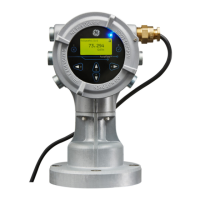PanaFlow™ XMT1000 User’s Manual 57
Appendix D. Foundation Fieldbus Communication
Appendix D. Foundation Fieldbus Communication
D.1 Introduction
Fieldbus is a bi-directional digital communication protocol for field devices, which offers an advancement in
technologies for process control systems and is widely employed by numerous field devices.
The
XMT1000 FF option is designed to the specification standardized by the Fieldbus Foundation, and provides
interoperability with devices produced by other manufacturers. The Fieldbus option
PCB comes with software
consisting of five
AI function blocks and one PID function block.
Note: For more general information on other features, engineering, design, construction work, startup and
maintenance of Fieldbus, refer to Fieldbus Technical Information (TI 38K3A01-01E).
D.2 Installation
D.2.1 Network Configuration
The following instruments are required for use with Fieldbus devices:
• Power supply: Fieldbus requires a dedicated power supply. It is recommended that current capacity be well
over the total value of the maximum current consumed by all devices (including the host). Conventional DC
current cannot be used as is.
• Terminators: Fieldbus requires two terminators. Refer to the supplier for details of terminators that are
attached to the host.
• Field devices: Connect the field devices necessary for instrumentation. XMT1000 has passed the
interoperability test conducted by the Fieldbus Foundation. To properly start Fieldbus, use devices that satisfy
the requirements of the above test.
• Host: Used for accessing field devices. A dedicated host (such as DCS) is used for an instrumentation line
while dedicated communication tools are used for experimental purposes.
D.2.2 Polarity
The XMT1000 Foundation Fieldbus terminals are marked (+) and (-). However, the design is polarity insensitive. This
means the XMT1000 will communicate even if the connections are reversed.

